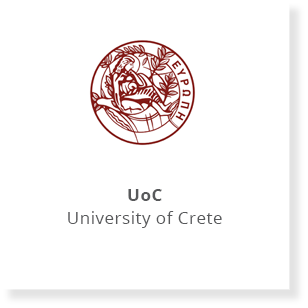





A great variety of tools are used by experienced staff according to the biophysical and structural method. For structural analysis CCP4 suite, Phenix suite, Pymol, Coot and ATSAS are provided. For Molecular dynamics Amber program is used. For the secondary structure prediction Phyre program, Jasco CD software, CDtool and CDpy are used.
EDUCATION
2019: PhD in Structural Biology and Protein Biomaterials (UoC, IMBB-FORTH - Greece)
2012: M.Sc. in Protein Biotechnology (UoC-Greece)
2009: Diploma Degree in Biology (UoC-Greece)
WORKING EXPERIENCE
Oct 2019 – Now: Post-Doctoral Researcher at I.M.B.B.-F.O.R.TH, Greece
(Laboratory of Structural Biology)
Sep 2020 – Now: Autonomous teaching and exam organizing of the under-graduate courses
"Enzymatic Biotechnology" and “Protein Engineering” at the Dept. of
Biology of the Uni. of Crete
2014 – 2020: Experienced scientist position at I.M.B.B.-F.O.R.TH, Greece (InnovCrete project /FP7-Regpot program) and at University of Crete
Oct. 2010 –Jan. 2011: Laboratory Teaching Assistant of Microbiology Teaching Lab
at the Dept. of Biology, Uni. of Crete
SELECTED PUBLICATIONS
*Kefala K., Kotsifaki D., Providaki M., Kapetaniou E., Rahme L. and Kokkinidis M. Purification, crystallization and preliminary X-ray diffraction analysis of the C-terminal fragment of the MvfR protein of Pseudomonas aeruginosa. (2012). Acta. Cryst F, 68, 695-697
*Kefala A., Kotsifaki D., Providaki M., Amprazi M. and Kokkinidis M. Expression, purification and crystallization of a protein resulting from the inversion of the aminoacid sequence of a helical bundle. (2017). ). Acta. Cryst F, 73, 51-53
Dimovasili C., Fadouloglou V.E., Kefala A., Providaki M., Kotsifaki D, Sarrou I., Plaitakis A., Zaganas I. and Kokkinidis M. Crystal structure of glutamate dehydrogenase 2, a positively selected novel human enzyme involved in brain biology and cancer pathophysiology. Journal of Neurochemistry (accepted)
RESEARCH PROFILE
Being in a Structural Biology group since 2011, Dr. Kefala A. has studied deeply the protein folding problem, elucidating the relation between amino acid sequence and structural properties of α-helical bundles. The knowledge obtained was used for protein design leading to bio-derived materials for bio-medical applications and basic research through structural studies of protein folding through reverse sequences.
Notable achievements include:
The elucidation of the protein folding of mutants of the α-helical protein Rop that is used as a canonical paradigm of this structural motif.
Protein design of novel protein-based biomaterials with specific engineered properties.
EDUCATION
2008: PhD at the European Molecular Biology Laboratory (EMBL) Hamburg Outstation, Germany (joint PhD with Heidelberg University, Germany).
2004: Diploma degree from the Department of Molecular Biology and Genetics, Democritus University of Thrace.
WORKING EXPERIENCE
2014-present: Experienced Scientist (Post-doctoral researcher) at IMBB-FORTH (partially funded from the REGPOT-InnovCrete program).
2013: Military Service.
2009-2012: Post-doctoral researcher at the Japan Synchrotron Radiation Research Institute jointly with the Department of Chemistry and Biochemistry, Kitakyushu University, Japan (JST-CREST grant).
SELECTED PUBLICATIONS
Mylonas E., Yagi N., Fujii S., Ikesue K., Ueda T., Moriyama H., Sanada Y., Uezu K., Sakurai K., Okobira T. (2019) Structural analysis of a calix[4]arene-based Platonic Micelle. Sci Rep, 9, 1982.
Charova S.N., Gazi A.D., Mylonas E., Pozidis C., Sabarit B., Anagnostou D., Psatha K., Aivaliotis M., Beuzon C.R., Panopoulos N.J., Kokkinidis M. (2018) Migration of Type III Secretion System Transcriptional Regulators Links Gene Expression to Secretion. mBio, 9(4), e01096-18.
Bernadó, P., Mylonas, E., Petoukhov, M.V., Blackledge, M. and Svergun, D.I. (2007). Structural Characterization of Flexible Proteins Using Small-Angle X-ray Scattering. JACS, 129, 5656-5664.
Tidow, H., Melero, R., Mylonas, E., Freund, S.M.V., Grossmann, J.G., Carazo, J.M., Svergun, D.I., Valle, M. and Fersht, A.R. (2007). Quaternary structures of tumor suppressor p53 and a specific p53 DNA complex. Proc Natl Acad Sci U S A, 104, 12324-12329.
Mylonas, E., Hascher, A., Bernadó, P., Blackledge, M., Mandelkow, E. and Svergun, D.I. (2008). Domain Conformation of Tau Protein Studied by Solution Small-Angle X-ray Scattering. Biochemistry, 47, 10345-10353.
SCΗOLARSHIPS, AWARDS and GRANTS
2004-2008: EMBL Fellowship, European Molecular Biology Laboratory (EMBL) Hamburg, Germany
2003: Academic Excellence Scholarship, Democritus University of Thrace- State Scholarships Foundation (IKY)
RESEARCH PROFILE
Efstratios Mylonas has worked on various systems such as proteins with intrinsic flexibility, non-coding RNAs, multimeric assemblies of proteins, protein-nucleic acids and even surfactants with potential use as non-viral gene delivery systems.
Notable achievements include:
The development of the Ensemble Optimization Method (EOM) for the analysis of flexible proteins, one of the most cited methods in the SAXS field.
The elucidation of the domain conformation of the natively unfolded protein tau, important in Alzheimer’s disease pathology.
The elucidation of structure of the full length tumor suppressor p53 free and in complex with DNA.
Structural analysis of surfactant assemblies with potential as gene delivery systems with SAXS and molecular dynamics simulations which led to the discovery of platonic micelles.
Characterization of nucleic acids with unusual structures, such as the immunostimulatory polypod-DNA and the cell cycle regulator non-coding RNA 6S.
Design of a restriction enzyme with new specificity.
Discovery of a direct link between expression and secretion in phytopathogenic Type III Secretion System by use of the same protein components.